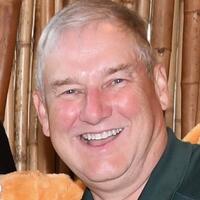Admission CTAs
GMU Graduate Finds Degree Skills Support His Research at NASA and in the Community
Dr. John Lyver has had a long and successful career, earning three degrees at George Mason University, working at NASA for 35 years, teaching at Northern Virginia Community College, and teaching CDS 130 and CDS 151 courses at Mason. He has recognized through these experiences as well as in a post-retirement project a skillset that has consistently supported his research and successful outcomes in very different environments for very different purposes.
In 1988, Dr. Lyver completed the MSECE (Master of Science in Electronic and Computer Engineering) degree, one of the predecessors of the current CDS Department at Mason, and began work on the NASA Space Station Freedom program. As a NASA civil servant he was promoted and assigned to work on the safety analysis of the nuclear materials that were planned for use on NASA’s Cassini spacecraft. Cassini was planned for launch in 1996 to investigate the Saturn utilizing about 75 pounds of Plutonium-238 Dioxide (an alpha emitter) and several more pounds of other nuclear materials used in heaters and instruments. The Pu238-O2 would be used in the process to generate the electric power needed to operate the spacecraft.
While still at NASA, John entered the Computational Science and Informatics Ph.D. program at Mason, and earned his MSCSI and CSI Ph.D. in 2010. “The CSI program was an educational version of the work that I had done for the Cassini Mission,” he said. “It gave me the tools to take massive amounts of varying data and turn it into information that leads to a decision.” When he retired from NASA in 2012, he taught physics, meteorology, and astronomy at Northern Virginia Community College, then taught CDS Department courses CDS-130 and CDS-151. He did not imagine that the large data analysis skills he had learned in the CSI Ph.D. program and used at NASA would ever be needed again.
However, in late 2021, he was invited to join a community group analyzing issues associated with possible construction of industrial data center buildings next to his community. As he investigated the political, historic, environmental, and health effects of the proposed construction, he realized that a few analyses would be needed to model parameters that the developer and the county had not analyzed. He soon learned that the modeling techniques learned in CDS/CSI courses for big data analysis could be applied successfully in a totally new field to solve a totally new problem.
For example, one of the issues that the developer had provided, but had no credible basis for, was the amount of tax revenue that might be generated from the construction of a few dozen data centers. So, Lyver was back in the big data modeling world. He admits to knowing little about the world of county real estate tax accounting or the development of data centers, but he knew that his CSI studies had given him the tools to do such an analysis. In one of his early modeling classes in CSI he learned to look at the information that was presented to do a quick examination of whether the data followed the expected relationships with regards to the situation and the “laws of physics.” In this case, the claim was that the resulting tax revenue was going to be a very high steady state value. To Lyver, it was obvious the expected tax revenues should have been more of a bell-shaped curve with “saw teeth” representing computer refits, upgrades, and business property depreciation. He was determined to build his model as a scientific analysis using the principles and techniques learned in CSI coursework.
So, he set out to gather as much information as he could to build a storyboard model. As in the NASA Cassini project, he and his team used a classic modeling. It was financial and not engineering-based, but the approach was just like what CSI had taught him. As they collected data, they had to also learn the processes and key components in how tax revenues are calculated. The team did extensive internet searches, but were unable to get enough data, much of which was not publicly available, to completely fill in the model parameters. So, in true CSI fashion, they worked the problem backward, taking tax records, data center industry marketing data, and even measurements from Google Earth to determine the base values and personnel requirements for a nominal data center. Then these calculations were repeated, normalized, and averaged together.
Since they did not know the specifics of how the data centers might be constructed near the community, they learned that the data could be scaled without losing integrity or increasing the uncertainty in the model. An additional benefit of using normalized data was that they could vary the size, number and configurations of clusters of data centers to better model the site. They went back to their storyboard and developed a time-phased schedule of when buildings would most likely be built, refit, and eventually decommissioned. When the model was reviewed by the County, the results were found to be credible and very representative of what the tax revenues might become. The results are currently being used in deciding the fate of a program which could either bring several billion dollars into the county or not.
“I truly think that a model is a model,” Lyver concludes. “This is a concept I didn’t realize as a Ph.D. student. I thought that tax modeling and molecular motion models would require totally different skill sets, but I was wrong. The only differences are the science disciplines involved and the software used to produce the model.”

